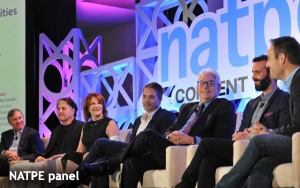
Imagine a world where all of television is commercial-free. According to one panelist at a session during last week’s NATPE conference in Miami Beach, that reality is already here
for an entire generation of younger viewers.
“There is a generation of viewers who are becoming accustomed to seeing everything without commercials,”
said panelist Mark Greenberg, president and CEO of Epix. It was an insight I had never thought of myself, and if this statement had come out of an ad industry panel session, the buzzing in the room
would have been palpable.
As it happened, this particular audience of programming types -- content creators, buyers, sellers and wannabes -- let the
statement go without any noticeable stir.
advertisement
advertisement
Greenberg was part of a panel titled “Scripted State of the Union: Will Creative Excellence Survive Tough
Business Realities?” NATPE is the National Association of Television Program Executives. Its annual conference -- formerly a marketplace for national syndicators to pitch their shows to
broadcasters – now attracts attendees from across the entire “content” spectrum.
This particular panel session was not primarily about
advertising, but the subject arose when the participants entered a discussion contrasting the scripted shows seen on pay cable and streaming services such as Amazon and Netflix and the ones that are
produced for commercial TV.
The consensus was that developing a hit show for a broadcast network still represents a “home run” for anyone who is
talented and/or lucky enough to come up with the next “Big Bang Theory.” But since such home runs are rare, creative types are gravitating more to these other program platforms where their
creative freedom is not restricted and the compensation, while not on the level of network television, is still nothing to sneeze at.
The place where
[creative] people are least likely to go to is conventional broadcast network television,” said one panelist, agent Peter Benedek, a founding partner in the United Talent Agency. “They
will freely forsake [the potential for a huge payday] to go somewhere they can really write something they’re going to be proud of,” insisted another panelist, Gary Levine, president of
programming for Showtime.
A great deal of the discussion was devoted to a programming executive who wasn’t there -- FX President John Landgraf, who has
been at the vanguard of developing edgy comedies and dramas in this current Golden Age of scripted TV. Landgraf’s opinion, which he first voiced last summer, is that there are really “too
many” quality scripted shows for audiences to really absorb. His “too much TV” comments have been widely discussed for months in the TV industry.
On the NATPE panel, opinions about what Landgraf said were mixed. Levine was one panelist who disagreed. “We seem to be the only part of the culture that bemoans an abundance of
quality programming,” he said. “When was the last time somebody complained there were too many good movies or restaurants in your neighborhood? There are 320 million Americans, and the
idea that there’s 400 scripted series is a disaster?”
Elsewhere at NATPE, another panel discussion focused on the intersection of TV content and
product-integration. And if we are heading toward a future in which commercial breaks are to be done away with, then integrating brands within TV shows will become all the more important -- perhaps
becoming the only way to “advertise” on TV (except for live broadcasts such as sports events whose built-in breaks are tailor-made for commercials and would likely remain so).
Among the participants on this panel -- titled “Masters of Marketing: What Brands Need to See” -- was producer Dan Harmon, best known as the creator of
NBC’s “Community.” The sitcom about a community college first aired on NBC and then had its final season last year on Yahoo.
“Community” was known for its brand tie-ins, particularly with Subway sandwiches. One infamous episode in 2012 had an entire storyline in which the brand was the central focus.
Not only was a Subway banner festooned across the set, but a guest character was actually named “Subway” and other characters greeted each other throughout the episode with the words
“Eat fresh.”
One might have expected Harmon -- a man known for being outspoken and rebellious -- to come out strongly against such an intrusion
on his TV show, but he said last week that he never had a problem with it, particularly after he got Subway to agree to not interfere with what he was doing. Among other things, Subway wanted a
representative on the set and Harmon refused. To his amazement, Subway backed off of this demand (and others), and still kicked in $300,000 toward the cost of production and Harmon was left to do
whatever he wanted.
Harmon said he felt at the time that Subway’s involvement in the show was no different than the involvement of the other corporate
partners he had to deal with -- namely, NBC, Sony, Paramount and all the other entities listed as co-producers.
“Everything is merging together now and
I’m looking forward to the day [when] there’s simply more people willing to pay money to tell stories,” Harmon said.